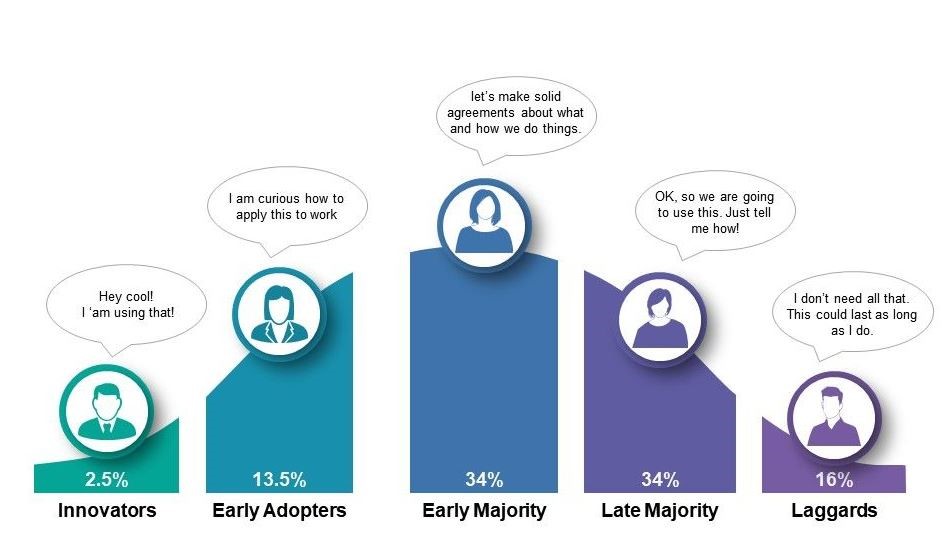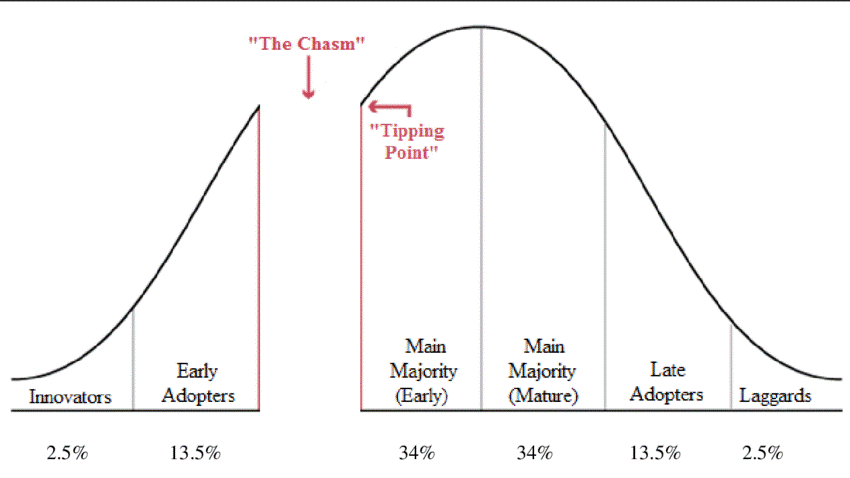I have been facilitating antiracism trainings lately where some attendees have been mandated by their employers to attend the training. The decision to mandate antiracism or diversity, equity, inclusion, and belonging (DEIB) training should be made carefully. While antiracism training can be valuable and effective when implemented thoughtfully, it is most effective when participants are engaged, willing, and open to the learning process. Mandating it for individuals who are not receptive may lead to a superficial compliance without genuine understanding or behavior change. It can also derail the experience for those who are receptive and came to learn. Models of innovation primarily used in business, marketing, and technology, may provide some insight.
The Diffusion of Innovations model, developed by Everett M. Rogers in 1962, is a theoretical framework that explains how new ideas, practices, technologies, or innovations spread and are adopted by individuals, groups, and organizations over time. It provides a structured framework for studying the adoption process, identifying influential adopters, and designing strategies for sustainable change. Rogers categorizes these groups based on their willingness to embrace new innovations.
- Innovators are the first to adopt an innovation. They generally have enthusiasm for new ideas, willingness to take risks, and tend to seek out and experiment with new technologies or concepts.
- Early Adopters are often opinion leaders within their communities and are willing to adopt innovations earlier than the majority. Their adoption helps legitimize the innovation and influence others to follow suit.
- Early Majority are typically more cautious than early adopters and require more evidence and assurance before adopting an innovation. Once they see that others have successfully adopted it, they are more likely to follow.
- Late Majority, like the early majority, tends to be cautious and skeptical of new innovations. They adopt innovations only when they have become a standard or accepted practice.
- Laggards are resistant to change and may adopt only when there is no other option.
 Over the years, researchers have made refinements to Rogers model to address its limitations and improve its applicability. Geoffrey A. Moore in his book "Crossing the Chasm” describes the "chasm" as a critical phase or gap that exists between the early adopters and the early majority in the adoption of an innovation. Moore’s focus is on the adoption of technology products and how they transition from a niche market to a more mainstream audience. He describes the adopter categories as techies, visionaries, pragmatists, conservatives, and skeptics.
Over the years, researchers have made refinements to Rogers model to address its limitations and improve its applicability. Geoffrey A. Moore in his book "Crossing the Chasm” describes the "chasm" as a critical phase or gap that exists between the early adopters and the early majority in the adoption of an innovation. Moore’s focus is on the adoption of technology products and how they transition from a niche market to a more mainstream audience. He describes the adopter categories as techies, visionaries, pragmatists, conservatives, and skeptics.

©Todreamalife, 2022
Some scholars say Malcolm Gladwell's book "The Tipping Point: How Little Things Can Make a Big Difference." can be seen as a stage within the Diffusion of Innovations Model. Gladwell explores the idea that certain small actions, events, or behaviors can lead to significant and often rapid social change or the "tipping point." It explores the moment when an idea or trend crosses the “chasm” and becomes widely accepted or “takes off.” Like Roger’s adopter categories, Gladwell identifies three types of people who play crucial roles:
- Connectors: These individuals have extensive social networks or “spheres of influence” and the ability to connect people from different social circles. They serve as bridges for the flow of information.
- Mavens: Mavens are information gatherers and experts who have in-depth knowledge about products, trends, or ideas. They are often sought out for advice and recommendations.
- Salesmen: Salesmen are persuasive communicators who can influence others' opinions and behaviors through their charisma and communication skills.

Malcolm Gladwell's work, and other writings on social dynamics and human behavior, can be valuable tools for social change. His insights offer practical strategies for understanding, influencing, and facilitating positive social change. Additionally, the Diffusion of Innovations model has been applied in a wide range of fields beyond its original context. So, while It may seem counterintuitive to focus on the people who are already on board, whether you are implementing a new DEIB initiative or a Strategic Plan, don’t neglect that first 16%. Ultimately, a comprehensive strategy that includes education, policy changes, and cultural transformation is essential for meaningful progress in most change efforts… and the willing can be critical in helping you get there.


